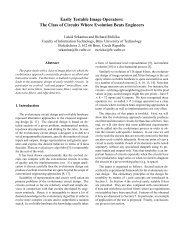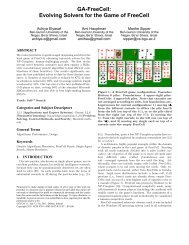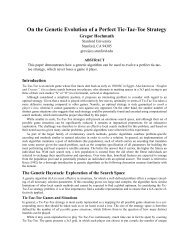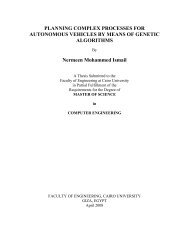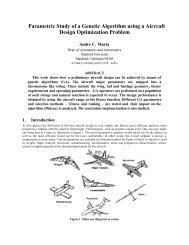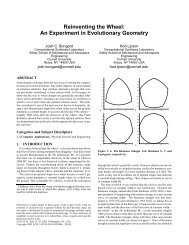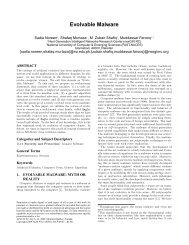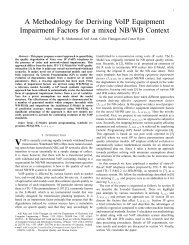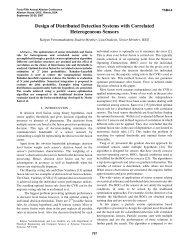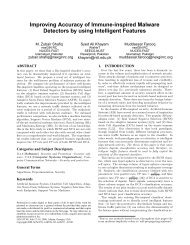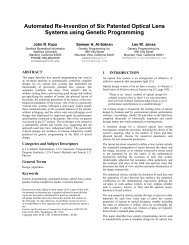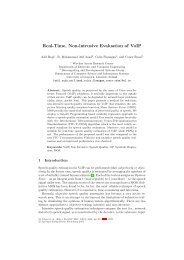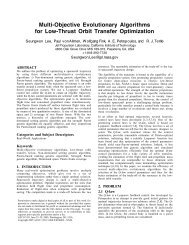Evolution of an Efficient Search Algorithm for the Mate-In-N Problem ...
Evolution of an Efficient Search Algorithm for the Mate-In-N Problem ...
Evolution of an Efficient Search Algorithm for the Mate-In-N Problem ...
You also want an ePaper? Increase the reach of your titles
YUMPU automatically turns print PDFs into web optimized ePapers that Google loves.
<strong>Evolution</strong> <strong>of</strong> <strong>an</strong> <strong>Efficient</strong><br />
<strong>Search</strong> <strong>Algorithm</strong> <strong>for</strong> <strong>the</strong><br />
<strong>Mate</strong>-<strong>In</strong>-N <strong>Problem</strong> in Chess<br />
Ami Hauptm<strong>an</strong> <strong>an</strong>d Moshe Sipper<br />
Ben-Gurion University, Israel<br />
2007 “HUMIES” AWARDS FOR HUMAN-COMPETITIVE RESULTS<br />
Monday, July 9, 2007<br />
1
Game-Playing AI<br />
Game Strategy =<br />
<strong>Search</strong>:<br />
<strong>Search</strong> + Knowledge<br />
Number <strong>of</strong> nodes developed<br />
Knowledge:<br />
Evaluation <strong>of</strong> nodes<br />
Trade<strong>of</strong>f between <strong>the</strong> two<br />
game tree<br />
…<br />
2
Chess: Machine Players<br />
Powerful contemporary engines<br />
Crafty, Fritz, Deep Junior, …<br />
Lots <strong>of</strong> search<br />
Less knowledge<br />
<strong>In</strong>telligent? Hmmm…<br />
Very little generalization<br />
Gobbles computational power<br />
Deemed <strong>the</strong>oretically uninteresting [Chomsky, 93]<br />
3
Chess: Hum<strong>an</strong> Players<br />
Use problem solving cognition<br />
Deeply knowledge-based<br />
play<br />
Massive use <strong>of</strong> pattern recognition;<br />
parallelism<br />
Also use search but<br />
Subst<strong>an</strong>tially less nodes (typically dozens)<br />
Selective (only “good”)<br />
More efficient: less nodes <strong>for</strong> “same” result<br />
Good source <strong>of</strong> inspiration <strong>for</strong> algorithms<br />
4
Our Goal<br />
Concentrating on endgames we previously:<br />
evolved node-evaluation function (knowledge) with GP<br />
Results: draw or win against CRAFTY, a world-class<br />
chess engine<br />
Part <strong>of</strong> work that won a 2005 humies medal<br />
This work: Evolve <strong>the</strong> search algorithm itself<br />
Evolve both search <strong>an</strong>d knowledge, letting<br />
evolution bal<strong>an</strong>ce <strong>the</strong> two<br />
5
<strong>In</strong>centive <strong>for</strong> Current Work<br />
Previously evolved players:<br />
Sometimes miss (easy) shallow mates<br />
Scaling problem: adding pieces to board decreased<br />
scores<br />
Evolved players should rely more on search<br />
Full pure-knowledge player still unattainable<br />
<strong>Search</strong> makes <strong>the</strong> strongest engines<br />
<strong>Problem</strong>:<br />
Simply adding search: too slow (each node thoroughly<br />
examined)<br />
SOLUTION:<br />
Bal<strong>an</strong>cing search & knowledge through evolution<br />
6
<strong>Problem</strong> Domain<br />
<strong>Mate</strong>-in-N: Is <strong>the</strong>re a <strong>for</strong>ced win sequence in<br />
maximum 2*(N-1) plies ?<br />
Crucial to chess engines, searched far more<br />
thoroughly<br />
CRAFTY: For difficult N=5 cases searches over<br />
10 6 nodes<br />
7
Major Result<br />
Evolved search algorithm:<br />
Number <strong>of</strong> nodes developed reduced by 47%<br />
with respect to world-class engine (not simple αβ)<br />
8
Result is Hum<strong>an</strong>-Competitive<br />
(H) result holds its own or wins a regulated<br />
competition involving hum<strong>an</strong>-written computer<br />
programs<br />
(B) better th<strong>an</strong> result accepted as a new scientific<br />
result at <strong>the</strong> time<br />
(D) result is publishable in its own right<br />
(F) better th<strong>an</strong> result considered <strong>an</strong> achievement<br />
at <strong>the</strong> time<br />
(G) result solves a problem <strong>of</strong> indisputable<br />
difficulty in its field<br />
9
Why is Result Best?<br />
Difficult <strong>for</strong> most hum<strong>an</strong> chess players:<br />
Must train intensively not to miss (<strong>an</strong>d lose game)<br />
Our evolved strategies improve upon one <strong>of</strong> top<br />
chess engines in existence (Crafty), representing<br />
m<strong>an</strong>y hum<strong>an</strong> years <strong>of</strong> programming<br />
We’re beating this top-notch engine in its own<br />
“territory”: massive search<br />
<strong>Problem</strong> is crucial to chess engines, <strong>the</strong>re<strong>for</strong>e<br />
much computational power is expended (e.g., in<br />
such positions, Deep Blue examines twice <strong>the</strong><br />
normal number <strong>of</strong> nodes)<br />
10
Why is Result Best? (cont’d)<br />
Evolving a dynamic algorithm (i.e., a process)<br />
usually harder th<strong>an</strong> evolving a static structure<br />
We took evolution to <strong>the</strong> next level: bal<strong>an</strong>cing<br />
search <strong>an</strong>d knowledge<br />
Surpasses previous EC solutions<br />
<strong>In</strong> a nutshell:<br />
1.Hard problem in hard domain <strong>for</strong> m<strong>an</strong> & machine (chess)<br />
2.Evolved algorithm better th<strong>an</strong> (most) hum<strong>an</strong>s<br />
3.Evolved algorithm better th<strong>an</strong> hum<strong>an</strong>-written top engine<br />
4.<strong>Evolution</strong> taken to next level<br />
11
A. Hauptm<strong>an</strong> <strong>an</strong>d M. Sipper<br />
<strong>Evolution</strong> <strong>of</strong> <strong>an</strong> efficient search algorithm <strong>for</strong> <strong>the</strong> matein-n<br />
problem in chess<br />
Proceedings EuroGP2007, pp. 78-89,<br />
April 2007<br />
M. Sipper, Y. Azaria, A. Hauptm<strong>an</strong>,<br />
& Y. Shichel<br />
Designing <strong>an</strong> evolutionary strategizing<br />
machine <strong>for</strong> game playing <strong>an</strong>d beyond<br />
IEEE Tr<strong>an</strong>sactions on Systems, M<strong>an</strong>,<br />
<strong>an</strong>d Cybernetics, Part C, 37(4),<br />
July 2007<br />
12



